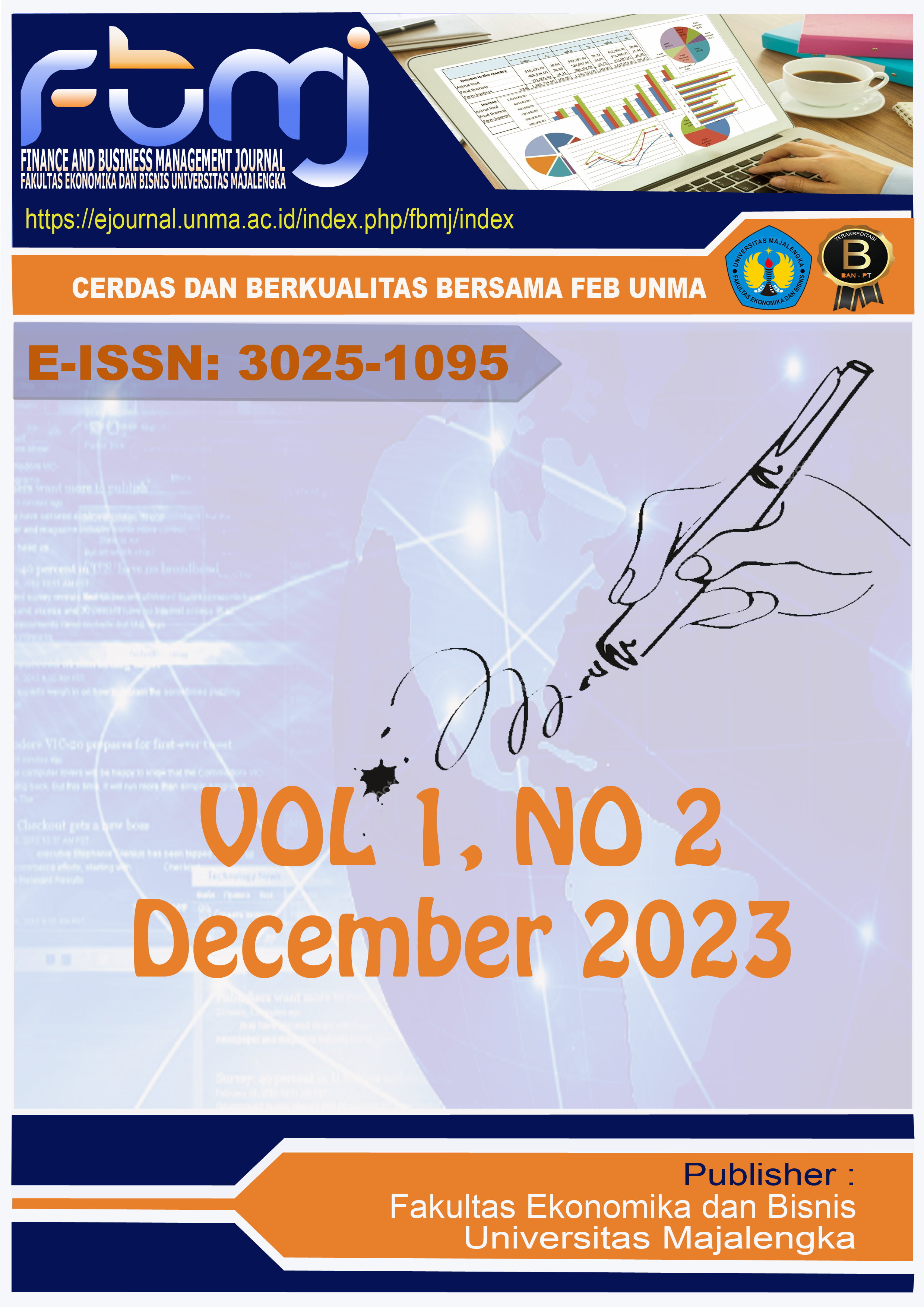Consumption Over Life Cycle Of Remittances Recipients In Indonesia
DOI:
https://doi.org/10.31949/fbmj.v1i2.7619Abstract
Purpose of this study is to examine and analyze the consumption patterns of remittance recipient households using the Life Cycle Hypothesis (LCH) model. Using data from three periods of the IFLS (IFLS 2000, IFLS 2007 and IFLS 2014) and the decomposition of cohort and age effects on consumption, the results show that consumption behavior is not as described as in the LCH theory. The curve of average consumption-age in this remittance recipient household has a "hump shape" pattern.
Keywords:
Age, cohort, consumption patternDownloads
References
dams, Jr., R. 1998. Remittances, Investment and Rural Asset Accumulation in Pakistan. Economic Development and Cultural Change, 47, pp. 155-173.
_________, Richard H., Cuecuecha, Alfredo dan Page, John. 2008. The Impact of Remittances on Poverty and Inequality in Ghana. The World Bank Policy Research Working Paper 4732
_________, R. dan Cuecuecha. 2010. The Economic Impact of International Remittances on Poverty and Household Consumption and Investment in Indonesia. Washington, DC.: World Bank Policy Research Working Paper 5433.
Alba, Michael M. & See, Edward C. 2006. Exploring Household Saving and Consumption Smoothing in the Philippines. Philippines Journal of Development, 61, 2nd Sem 2006, pp. 77-99.
Alderman, Harold. 1996. Saving and economic shocks in rural Pakistan. Journal of Development Economics Vol. 51 (1996) 343-365
Amuedo-Dorantes, Catalina dan Pozo, Susan. 2011. New evidence on the role of remittances on healthcare expenditures by Mexican households. Rev Econ Household 9:69–98
Ahmed, Junaid dan Mughal, Mazhar. 2014. How do consumption patterns of foreign and domestic remittance recipients and non recipients compare? Evidence from Pakistan. Georg-August-Universität Göttingen: Discussion Papers No. 160
Ang, Alvin P., Guntur Sugiyarto and Shikha Jha. 2009. Remittances and Household Behavior in the Philippines. ADB Economics Working Paper Series No. 188
Aguiar, Mark dan Erik Hurst. 2013. Deconstructing Life Cycle Expenditure Journal of Political Economy. vol. 121, issue 3, pages 437 – 492
Bank Indonesia, Statisktik Ekonomi Indonesia, Berbagai Tahun
Bank Indonesia. 2008. Neraca Pembayaran Indonesia dan Posisi Investasi Internasional Indonesia: Konsep, Sumber Data, dan Metode. Jakarta: Direktorat Statistik Ekonomi dan Moneter
Baltagi, H. Badi. 1995. Econometric Analysis of Panel Data: John Wiley & Sons.
Barai, Munim K. 2012. Development Dynamics of Remittances in Bangladesh. SAGE Open 1–13
Cattaneo, Cristina. 2010. Migrants’ International Transfers and Educational Expenditure: Empirical Evidence from Albania. Global Challenges Series
Carriker, G. L., Langemeier, M. R., Schroeder, T. C., & Featherstone, A. M..1993. Propensity to Consume Farm Family Disposable Income from Separate Sources. [Article]. American Journal of Agricultural Economics, 75(3), 739-744.
Clément, Matthieu. 2011. Remittances and Household Expenditure Patterns in Tajikistan: A Propensity Score Matching Analysis. Asian Development Review, vol. 28, no. 2: pp. 58–87
Connel, Jhon, Biplab Dasgupta, Roy Laishley, Marchael Lipton. 1976. Migration From Rural Areas, The Evidence from Village Studies. Delhi: Oxford University Press.
Cuong, Nguyen Viet. 2012. Economic impacts of international migration and remittances on household welfare in Vietnam. International Journal of Development Issues Vol. 11 No. 2, 2012: pp. 144-163
Dartanto, Teguh dan Nurkholis. 2010. Income Shocks and Consumption Smoothing Strategies: An Empirical Investigation of Maize Farmer’s Behavior in Kebumen, Central Java, Indonesia. Modern Economy, 2010, 1, 149-155
Davies, S., Easaw, J., & Ghoshray, A.. 2009. Mental Accounting and Remittances: a Study of Rural Malawian Households. Journal of Economic Psychology, 30(2), 321-334.
De Hass, Hein, 2008. Migration and Development : A Theoretical Perspective. International Migration Institute
Deaton, A..1997. The analysis of household surveys: a microeconometric approach to development policy. Baltimore, MD: Johns Hopkins University Press
Englama, Abwaku. 2009. The Economics of Remittances: Theories and Issues. Banjul: The Regional Seminar on High-level Seminar on International Remittances for Economic Development
Fernandez, Emilio dan Corugedo. 2004. Consumption Theory. London: Handbook in Central Banking No.23
Fernando Alexandre & Pedro Bação & Miguel Portela, 2019. Is the basic life-cycle theory of consumption becoming more relevant? Evidence from Portugal, Review of Economics of the Household, Springer, publish on line: 28 November 2019.
Friedman, Milton. 1957. A Theory of the Consumption Function. New Jersey: Princeton University Press
Gourinchas, P. O. & Parker, Jonathan A. 2002. Consumption over the Life Cycle. Econometrica, Vol. 70, No. 1, pp. 47-89.
Greene A.. 2003, Econometric Analysis, Fifth Edition. New York University.
Gudjarati, Damodar. 2004. Basic Econometrics, Fourth Edition. New York: The McGraw−Hill Companies
Hadiyanto, Ferry. 2011. Does indonesian household saving has cycle?. Indonesian Journal of Economics and Bussiness Vol 1, No 3.
Hadiyanto, Ferry. 2010. Analisis Perilaku Konsumsi dan Tabungan Rumah Tangga dalam Pertumbuhan Ekonomi di Indonesia: Suatu Pendekatan Dengan Teori Hipotesis Siklus Hidup. Bandung: Disertasi pada Pascasarjana Unpad
Hagen-Zanker, Jessica dan Siegel, Melissa. 2007. The Determinants of Remittances: A Review of The Literature. Maastricht University dan Maastricht Graduate School of Governance: Working Paper MGSoG/2007/WP003
Hall, R. E..1978. Stochastic Implications of the Life-Cycle-Permanent Income Hypothesis: Theory and Evidence. Journal of Political Economy, 86(6), 971-987.
Hill, Carter, R., Griffiths, W.E., dan Guay C.Lim. 2012. Principles of Econometrics, 4th edition. John Wiley and Sos, Inc.
Haviland, W.A. (2003). Anthropology. Wadsworth: Belmont, CA.
Hsiao, Cheng. 2003. Analysis of Panel Data, Second Edition. United Kingdom: Cambridge University Press
Hugo, Graeme. 2014. The Changing Dynamics of ASEAN International Migration. Malaysian Journal of Economic Studies Vol. 51 No. 1 hal 43-67
Hoddinott, J.. 1994. A Model of Migration and Remittances Applied to Western Kenya. Oxford Economic Papers, Vol.46, No.3, pp.459-476
International Monetary Fund. 1993. Balance of Payments Manual. fifth edition.
Jappelli, T & Pistaferri, L. 2010. The Consumption Response to Income Changes. The Annual Review of Economics, 2:479-506.
John Gibson & Grant Scobie, 2001. "A cohort analysis of household income, consumption and saving," New Zealand Economic Papers, Taylor & Francis Journals, vol. 35(2), pages 196-216.
Kalaj, Ermira H. 2015. A Micro-level Analysis of the Effect of Remittances on Health Expenditures: Evidence from Albania. Mediterranean Journal of Social Sciences. Vol 6 No 1 S1:665 – 673
Levin, L.. 1998. Are assets fungible? Testing the behavioral theory of life-cycle savings. Journal of Economic Behavior & Organization, 36, 59-83.
Lu, Yao. 2014. Household Migration, Remittances, and Its Impact on Health in Indonesia. Int Migr. 2013 July 1; 51(Suppl 1): . doi:10.1111/j.1468-2435.2012.00761.x.
Mankiw, Gregory N, 2012. Macroeconomics. Eighth Edition. New York:Worth Publishhers
Modigliani, F., 1986. Life cycle, individual thrift and the Wealth of nations. The American Economic Review Vol. 76, No. 3 (Jun., 1986), pp. 297-313. stable URL: http://www.jstor.org/stable/1813352
______ & Brumberg, R. 1954. Utility Analysis and The Consumption Function: An Interpretation of Cross-Section. Papers of Franco Modigliani Volume 6. London: MIT Press
Nguyen, V.C., 2009. The Impact of International and Internal Remittances On Household Welfare:Evidence From Viet Nam. Asia-Pacific Development Journal Vol. 16, No. 1. Hal 59 – 92.
Nicholson, Walter dan Snyder, Chirstoper, 2008. Microeconomic Theory: Basic principles and Extensions. Tenth edition. Mason:Thomson South-Western
Osili, Una Okonkwo.2007. Remittances and savings from international migration:Theory and evidence using a matched sample. Journal of Development Economics 83 (2007) 446–465
Pangaribowo, Evita Hanie. 2011. Demand for Food of Indonesian Households: Evidence from Longitudinal Data. DAAD and Fiat Panis Foundation
Randazzo, Teresa dan Piracha, Matloob. 2014. Remittances and Household Expenditure Behaviour in Senegal. Forschungsinstitut zur Zukunft der Arbeit Institute for the Studyof Labor: IZA Discussion Paper No. 8106
Rapoport, Hillel dan Docquier, Frédéric. 2005. The Economics of Migrants’ Remittances. Bonn: IZA Discussion Paper No. 1531
Samuel, Wendell. 2005. Migration and Remittances: A Case Study of The Caribbean dalam Dennis Pantin (Penyunting). “The Caribbean Economy: A Reader”. Hal 571-589. Khingston: Ian Randle Publishers
Snyder, Steve dan Chern, Wen S.. 2009. The impact of remittance income on rural households in China. China Agricultural Economic Review Vol. 1 No. 1, 2009: pp. 38-57
Stark, Oded dan Robert E. B. Lucas. 1988. Migration, Remittances, and the Family. Economic Development and Cultural Change, Vol. 36, No. 3 (Apr., 1988), pp. 465-481
Suarez, Juan Carlos dan Avellaneda, Zenide. 2005. Juanita's Money Order: Income Effects on Human Capital Investment in Mexico. UC Berkeley: Institute for Research on Labor and Employment
Sullivan, arthur (2003). Economics: Principles in action. Upper Saddle River, New Jersey 07458: Pearson Prentice Hall. hlm. 29. ISBN 0-13-063085-3.
Taylor, J. Edward. 1999. The New Economics of Labor Migration and The Role of Remittances in The Migration Process. International Migration Vol. 37 (1).
Thomas, R.L. 1997, Modern Econometrics: An Introduction. Addisson-Wesley.
Tjiptoherjianto, P. 2000. Urbanisasi dan Perkembangan Perkotaan di Indonesia. Jakarta: Lembaga Penerbit FE – UI.
Tjiptoherjianto, Prijono. 1982, “Sumber Daya Manusia, Kesempatan Kerja dan Pembangunan Ekonomi”,Lembaga Penerbit FE – UI. Jakarta.
Thaler, R. H.. 1990. Anomolies: Saving, Fungibility, and Mental Accounts. J. Econ. Perspectives 4 (Winter 1990): 193-205
Todaro, Michael P. 2012. Economic Development. New Jersey:Prentice Hall.
United Nations. 2010. Maximizing the development impact of Remittances. Geneva: United Nations Conference on Trade and Development
Ullah, Asmat, Hussain, Syed Waqar dan Khan, Zahoor. 2012. Micro-econometric Analysis of Impact of Remittances on Household’s Welfare: Empirical Evidence from District Peshawar. Oeconomics of Knowledge, Volume 4, Issue 1, 1Q
Uzagalieva, Ainura dan de Menezes, António Gomes. 2009. The Poverty Effect of Remittance Flows: Evidence from Georgia. CEEAplA Working Paper No. 06
Villaverde, F. J. & D. Krueger. 2004. Consumption and Saving over the Life-Cycle: How Important are Consumer Durable. Meeting Papers 357b, Society for Economic Dynamics.
Wahba, S.. (1991). What Determines Workers Remittances?. Finance and Development Vol. 28. No. 4: 41 - 44.
Yang, Dean. 2011. Migrant Remittances. Journal of Economic Perspectives—Volume 25, Number 3:129–152
Zhu,Y. Wu, Z. Peng, L dan Sheng, L. 2014. Where did all the remittances go? Understanding the impact of remittances on consumption patterns in rural China. Applied Economics. Vol. 46, No. 12, 1312–1322, http://dx.doi.org/10.1080/00036846.2013.872764

Published
How to Cite
Issue
Section
License
Copyright (c) 2023 Ade Jamal Mirdad, Sutyastie Sumitro Remi, Ferry Hadiyanto, Bagdja Muljarijadi

This work is licensed under a Creative Commons Attribution-ShareAlike 4.0 International License.
An author who publishes in the Finance and Business Management Journal agrees to the following terms:
- Author retains the copyright and grants the journal the right of first publication of the work simultaneously licensed under the Creative Commons Attribution-ShareAlike 4.0 License that allows others to share the work with an acknowledgment of the work's authorship and initial publication in this journal
- The author is able to enter into separate, additional contractual arrangements for the non-exclusive distribution of the journal's published version of the work (e.g., post it to an institutional repository or publish it in a book) with the acknowledgment of its initial publication in this journal.
- The author is permitted and encouraged to post his/her work online (e.g., in institutional repositories or on their website) prior to and during the submission process, as it can lead to productive exchanges, as well as earlier and greater citation of the published work













